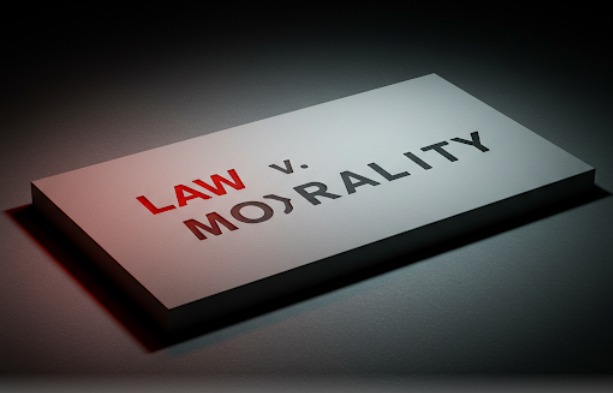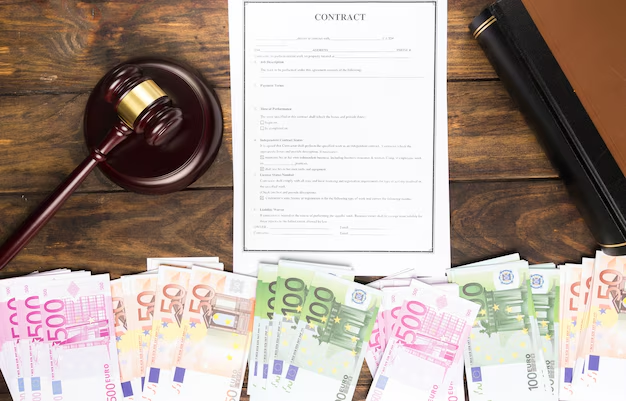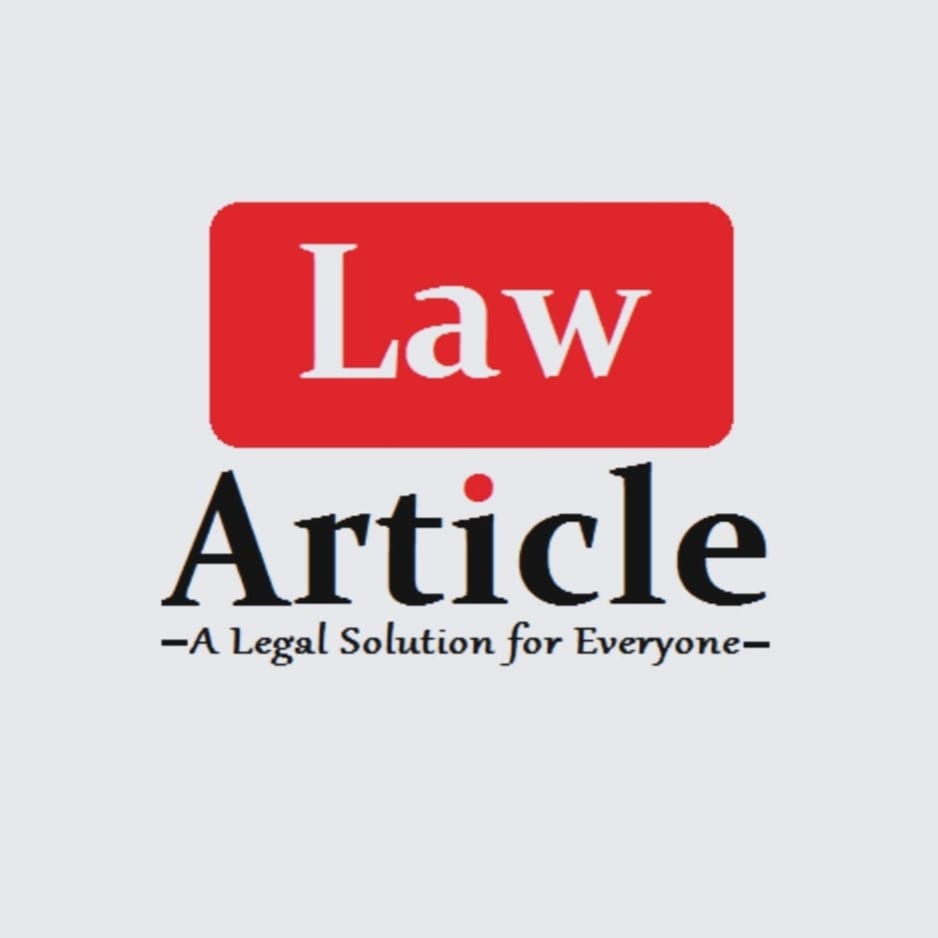INTRODUCTION
The world we live in is made up of countless values, ideals, beliefs, rules and norms which further forms the basis of our behavior in the society. Hence, it becomes necessary to understand the differences so that one could avoid the ambiguity. There are two such concepts which are often talked together: Law and Morality.
‘Laws’ are basically formal rules which specifically define an individual’s behavior in a society. Laws are implemented by the state and judiciary in order to have certain kind of standard behavior by the individuals in a given society, particularly, aiming at the welfare of the society. While the concept of ‘morality’ refers to an informal framework which includes values, principles, customs, traditions and beliefs. Morals are not legally enforceable rather it is based upon societal norms.
Through the ages the concepts of law and morality has been studied in the light of Hart-Fuller conflict but it’s found that the basic concept of law and morality dwells in the social systems of the contemporary times. When we look at the primordial civilization, we find that there existed no variance as far as law and morality are concerned rather, they had similar origin; for example; custom used to go with hands clasped. But now after deeply observing the circumstances; we find, that there is a huge difference between the two. There are contradictions that prevail between the two concepts as the primitive idea was to enforce morality by way of law which will create an ideal and peaceful society which do not seem to coincide with modern times as the idea of law and morality diverge at many places.
Law is primarily an enactment put together by the State and supported by pressures and constraints where breach of these set of rules and regulations would result in penalizing by the courts which reflect the state’s will. If we closely observe, we find, that law traverses the boundaries and builds a bridge across the society whether it’s political, social and economic which further narrows down the divide and aids the government in its functions. Thus, law depicts the sociological needs of the society whereas morality is about the moral attitudes and rules of conduct which are analogous to certain psychological and social attributes and it governs the human behavior invariably within the community or class.
In the prehistoric era it is believed that this code of conduct was relegated by the divine himself. Hence, it can be understood that law basically revolves around the ‘individual’ and the individual has a ‘free will’ but as far as morality is concerned there is only one will that is ‘will towards the good’. Law is based on the external conduct and it has no relationship with the intention or faith of an individual while morals are not based on external conduct of the person. So, we draw an idea from this, that on the one hand, state has the authority to validate law while on the other hand, the authority to validate morality rests with the society.
The Philosophy of Law
Jurisprudence studies the nature of law and it’s interplay with other fields of inquiries. The jurists have been examining and observing this issue in number of ways. They have applied various approaches so as to draw a parallel with what exactly jurisprudence and its concepts stand for. Predominantly, all the methods and techniques are collectively referred as ‘schools of jurisprudence’ and it serves as a legal guide for the students of natural law institution. On the one hand, according to history, ‘law is the product of the past’ while, on the other hand, according to the sociological school, ‘law is the fact in the world’. The realists believe that the courts decisions determine the laws.
It was Sir John Austin who penetrated the barriers of ethics, politics, history, and sociology to construct a coherent picture of how law works judiciously. Sir John Austin had the courage to say that law was the creation of individuals for themselves. So, this also proves that the state is more powerful than the church. Despite its truthfulness, Austin’s theory was not considered perfect by Salmond because it has discerned that civil law is a product of the state and it entails the state’s physical authority to be extant by way of judicial courts. It implies that, there can be no civil law in existence if the state does not apply a physical force to govern a community. Paton Austin1 is of the opinion that a fully developed legal system has a state-like legal order but it is difficult to say that there could be any law without the state.
Prof. Julius Stone2 concurs and says that the analytical approach is apathetic towards justice and social truths. If the law is analysed, synthesised and classified, it is perceived as an exception from rest of the world.
The positivists do not concede law as law, as they do not incorporate morals in their perspective. Prof. Hart opposes the theory of command. This is indicative of the fact that he believes that law does not apply to gun owners. The command should not be given by someone who employs force. Furthermore, Savigny, the founder of the historical school, holds that law cannot be designed or modified by the politicians. According to Savigny, law is not influenced by reason, order or will of the Sovereign rather it is the outcome of internal pressures that have been working clandestinely.
People believe in law because it is primarily based on the common belief system, practices, and the traditions. In fact, law is living thing like language which changes with time. Prof. Dias believes that Volk Geist has some authenticity because there is an outflux of progression and practice, but maintaining the same in entirety is quite challenging. Hence, Savigny believed that it was something which could be unearthed as people have different approaches even in a small group and ‘The Spirit Does Not Exist’.
Some legal scholars have different perspectives on the law. The analytical jurists contemplated law in terms of its source, which was the sovereign’s order. The historical school referred to this as ‘continuity of law from custom’. They contend that the law has made headway overtime as a result of how people have been conducting themselves. Law is produced by abiding by it not merely by contemplating about it. Law prevails over legislation. The Sociological jurists apply social engineering to scrutinize how legislation could be used to balance the conflicting interests with the minimal resistance. Realists are of the opinion that the judges have the authority to reiterate the law which implies that legislation has no relevance upon law. The law is what the judges say which is also inferred as ‘dog’s law’ by some. Due to this, we can see that every judge addressed a different legal issue.
The Concept of Morality
Morality implies principles that govern the distinction between right and wrong or good and bad behavior. Morality is primarily a collection of values that authorizes people to live together in communities. The concept of value marks the beginning of morality. The rational human nature is the basic norm of morality. Besides, morality forms the basis of transmuting the known order of values. Thus, if we put it precisely, morality is nothing beyond the adherence to the rules which modulate the human life, for example, the power of reason.
Morality as the Basis of Law
History does not show any clear distinction between law and morality. As there is lack of distinction all the laws find their origin from something that was considered morally correct by the society at the given point of time. In the due course, the state chose what was morally right and framed it as laws, rules and regulations. It is due to this; we find a lot of similarity between these two concepts. For example; rape and murder are morally wrong and this value is also a kind of law. Hence, even if morality has been separated from law, it continues to be an integral part of legal development. Law intrinsically involves some basic principles like fairness and equality and these principles are taken from ethics.
Queen vs. Dudley and Stephen’s Case3:
In this case, the court held that one person cannot sacrifice another person’s life to save his or her own. On the basis of these facts, there was no evidence of any necessity that could justify the prisoners in killing the boy and they were guilty of murder. It becomes very much clear by the decision in this case that what appeared to be morally right from the eyes of the defendants was considered as a crime in the eyes of law.
Oppenheimer vs. Cattermole4:
This is the judicial decision of English Courts which discussed whether the English law should not acknowledge the laws of Nazi era which related to the appropriation of Jewish property. The courts contemplated the question as to whether the Nazi law was so immoral that it should decline to concede it as law. This raised the ‘connection between law and morality’.5
In this case, with regard to the issue of double taxation relief, The Nazi decree of 1941, deprived the German taxpayer of his nationality but he was still liable to pay taxes under German law 1913. It was held, that the English law, was bound to acknowledge the German decree of 1941 as effective and so from that day onwards the German national would acquire the British nationality.
In the House of Lords, Lord Cross of Chelsea famously held: ‘a law of this sort constitutes so grave an infringement of human rights that the courts of this country ought to refuse it as a law at all.’
Morality As a Test of Law
The main purpose behind the existence of laws is to guarantee justice in society and do what is in the best interest of people. The principle of justice falls in the confines of morality, a number of jurists believe that both are supplementary to each other rather than being contradictory to each other. The laws which are not in consonance with the moral standards should be removed and it should be evaluated with moral values of the society.
Morality As Ends of Law
As discussed above, the primary aim of enacting the laws is to have a society which is based on principles of justice, fairness and equality. The main idea is to avoid conflicts. The jurists believe that morals and laws go hand in hand; one cannot be ignored at the cost of other. This is because if any law is in conflict with the pre-existing moral and values, people may not conform to it, leading to further conflict in the society.
The Concept of Law and Morality
There has been a huge divide among scholars and legal experts as far as the interrelationship between these two concepts of law and morality is concerned. One school of thought opines that law and morality are in contrast with each other while on the other hand, another school of thought varies from the said idea as they believe that both are closely intertwined. Conventionally, morality has been held as an indispensable part of all human enterprises. It is for the reason that the sense of morality is a kind of spontaneous process that guides us to choose one thing over another. Morals basically are the mechanical forces that guide us to select the right or wrong or to behave in a certain way. Thus, morality is a sort of power that evolves from within and engages the entire value system of a person.
Bentham has referred to the term ‘social punishments’. Social punishments are imposed on individuals when they fail to follow laws and principles. ‘Social Penalties’ refers to those situations that arise when there is a failure on the part of society with respect to the standard and values. The quintessential moral code’s laws, such as, God’s law’s, the norms, are everlasting. However, the society at large does not follow such ideas. They follow the universal rule of happiness or sadness. These universal principles are called as ‘positive law’. The concept of ‘positive morality’ touches upon the concepts that the community once thought to be best to press upon the human conscience as compulsory at a given point of time. Morals vary from one place to another and so the individuals might have differing opinion on similar moral issue.
The concept of positive morality encompasses the natural law principles as well as religious convictions of what is virtuous and what is not. It is due to the general opprobrium that individuals are driven to do good. On the contrary, the moral norms are backed by the inner principles and values that every individual possesses. Every community has a set pattern of functioning wherein there is a correlation between social justice and the way other instruments perform their task in the legal system. From this, it can be concluded, that law and morality can never be completely detached with each other in a civilised society. The society has transformed; it has become more vociferous and collocated which has made the role of law more essential in order to establish social morality.
Therefore, any legal theory that claims law as a set of rules which might be executed must take into account this aspect of the association. The positivist theorists such as Kelson and Austin have advanced that the law and legal order do not rest on moral principles rather they believe that ‘the meta legal foundation’ is the mainstay of law and the legal system. There has always been an enormous confusion between law and morality but they are very different with each other. The rule of law is premised on the basis of government’s assessment of what is best for its people. This infers that public policies should be based on health concepts that the population believes to be pertinent at the given time and place. In the present set up of democracy, the basis of laws is public opinion.
HART-FULLER DEBATE ON LAW AND MORALITY
The Hart-Fuller debate is one of the finest exchanges of ideas and opinions on the concept of law and morality. This was published in the Harvard Law Review in 1958 and it highlighted the differences in the opinions in the positivist and natural law philosophy. In order to understand the ideas of these Ideologists, it is necessary that we analyse their thoughts and reasoning behind them separately.
H.L.A HART6
Hart being a positivist believes that there is an intricate bond between law and morality; though both are not in consanguinity. Hart does believe the fact that morals prevailing in the society have influenced the laws. Besides, he says that there should be a clear distinction between what law should be and what it ought to be. This brought in the ambiguity. On this Fuller opposed his theory and opined that there are certain circumstances where the law is not clear, the judges give decisions based on morality primarily on the basis of what ought to be. Hart retaliated to Fuller’s idea and said that in order to ascertain what ought to be must be understood from a legal sense and not from the moral point of view. The explanation of law should not come from outside the legal arena.
The law has both primary rules and secondary rules. Primary rules are those that impose some kind of regulations on the individuals while secondary rules aim at providing power to the state to frame and implement the laws. This clarifies that laws don’t have to associate themselves with moral standards. But despite making such clear differences between law and morality, he is of the opinion that the two are bound to cut across the same point.
LON FULLER7
Fuller being a naturalist believes that there is a very strong connection between the law and morals. He further believes that, all legal norms are premised on moral norms. Besides, the law cannot be valid if it does not get through the test of morality which is based on ethical ideas that people strongly believe.
According to Fuller, morality can be divided into two categories: ‘morality of aspiration’ and ‘morality of duty’. The former is concerned with the moral norms that a person follows for their best interest. The latter on the other hand seems more pertinent to the effective operation of society by prescribing standards meant to be followed by all. Fuller also spoke about two other concepts; known as ‘Internal morality of law’ and ‘External morality of law’. Internal morality implies framing of laws while the external morality talks about the essence of law that we use to make decisions.
An Analysis of Hart-Fuller Debate:
Both the philosophers aimed at attaining justice but they differed in their ways of achieving the same. Their ideologies could be best understood with the help of real-life examples. Let’s take the example of a situation where it is prohibited to park a vehicle in a particular place. Now the point is parking the vehicle in that place is not wrong morally, but is still against the law. This implies that the existence of law could be exclusive of moral obligation of interference or dependence which is the core idea that Hart has established.
In yet another example, let’s take a look at the Nazi regime when the laws enacted by Hitler completely lacked morals and values. It is a general view that the Nazi regime was unfair and cruel to humanity, and the result of that was not justice. Fuller’s idea fits in here that when the laws were not in conformity with morals, it led to injustice.
After carefully examining both the legal philosophers we can draw an idea that their ideas strike a bargain. Morality and law can intersect and overlap at many places. However, the legal world might rest on rationality because morality is subjective.
The Relationship Between Law And Morality8
The precise areas of relationship between law and morality could be stated in the following manner:
- Law is interlinked with morality in enunciating those virtues that are related to the common good. This does not imply that the positive human laws should interdict all evil-doing nor command all the virtues rather it aims to forbid the gross failings of human beings which imperil the very existence of society and commands those values which could be laid down by human means to the common good.
- Law is linked with morality by the moral obligation imposed which infers by the necessity of an act which is in relation to the necessary end because law as a commandment of practical reason essentially implies an obligation. Thus, the obligation proceeds through the necessary conviction of law as an compelling dictum of practical reason, i.e., an interrelationship of some necessity between the act that is directed and the end for which that act is directed. However, the positive human laws’ obligation is not in that same manner as morality’s obligation.
- The law is intertwined with morality because both have their origin in the same source known as practical reason and prudence.
- Law is connected to morality because law is subject to and cannot refute the moral principles.
- Law is fastened with morality because justice is not only a legal concept but a moral concept as well. Justice outside the domain of morals and values is meaningless. This is because the essence of justice lies in the creation of equality.
- There is a very close link between law and morality as far as Indian laws are concerned. As a matter of fact, the Constitution of India has given a crystal-clear example with respect to this. The Fundamental Rights; i.e., Part III of the Constitution (Articles 12-35); Directive Principles of State Policy (Articles 36-51), all these are based upon morality and these moral values have been moulded into laws and they are followed by each and every citizen of India.
- Since the formation of Indian Penal Code, morality has been given a special place in laws as it is a latent ingredient of almost every section. There are two basic essentials that are needed to establish a criminal liability called as ‘mens rea’ and ‘actus reus’. ‘Mens rea’ means wrong or the mala fide intention or the guilty mind and intention implies the conscious exercise of a person’s mental faculties to perform an act. The legal maxim here means that if an act is done without the mala fide intention then it is not an offence. Here, we find, that the chain of law is interlinked with morality as wrongful intention would definitely denote a thought of an immoral task. Other provisions from IPC could be illustrated here, such as, Section 34 which talks about ‘common intention’ and ‘wrongful act’; Section 52 defines ‘Good Faith’ which means an act done with bona fide motive wherein the person is believed to have a good moral character.
Hence, we see that morality is not only strongly related with the Indian Penal Code but it also forms an integral part of Indian legal scenario. It is the situation where it becomes crystal clear that morality plays an important role as it influences the law to an extreme level by providing a reasonable basis to prove the whole gamut of immoral actions as illegal.
Divergence of Law and Morality9
Both law and morality have a numerous reasons to have different perspectives but one thing they certainly have in common that both affect our lives at some point. Law and morality both keep evolving with the changing times. Recently, the entire thought process of the society went through a sea-change because the idea of morality varies from person to person. This infers that morality has become subjective; what is morally right for one might be morally wrong for another.
Morality has transformed into a dynamic concept of late so it has become very difficult for the lawmakers to base laws on morals on the contrary, there is a huge clash between these two concepts and there are number of issues where these two concepts should not be overlapping. The new laws should be based on the pre-existing legal framework. There is need for a progressive framework, which may not be completely in line with the modern world and ideas but there is a need to enact such laws which are not only morally upright but they ensure justice as well.
Likewise, there have been number of issues where law and morality have diverged where the rules are not considered moral but the laws are framed and implemented. Some examples to justify the facts are as follows:
Homosexuality laws:
The concept of law and morality are ever changing which keep evolving with time. According to the sociological jurisprudence, the law ought to evolve in order to meet the needs of society. There are many states who have been following this principle and coming with new laws which are progressive in nature. Sometimes, morals have to be overlooked if it acts as a hurdle for progressive laws. The landmark judgement of Navtej Singh Johar vs. Union of India,10 confirmed the rights of the homosexuals, stating that love is love itself. Prior to this, the homosexuals were the marginalised sections of society and they were left in narrow tunnels.
The coveted Indian Penal Code, drafted in 1860, under Section 377 had set down that whoever had carnal intercourse voluntarily with any man, woman, or animal, which is against the order of nature, shall be punishable. IPC Section 377 criminalized any penetrative sex that was unnatural and didn’t lead to reproduction, hence, the sexual expressions by the homosexuals, bisexuals, etc. would be considered as criminal offences. But due to the whole lot of pressure created by the LGBTQ community for their rights in the year 2006, the Supreme Court of India, directed the High Court to examine the constitutional validity of Section 377. Many organizations came forward together such as Naz Foundation and NACO (National Aids Control Organization) called upon for scrapping of Section377. Besides, 172nd report of the Law Commission of India, urged for the decriminalization of homosexuality. Eventually, on 6th September, 2018, a 5-judge constitutional bench of Supreme Court of India invalidated some parts of Section 377 of IPC.
Thus, from this landmark judgement, it becomes quite visible, that the line of morality has faded because the mindsets have advanced over the years and has overpowered the traditional moral standards to give way to more progressive laws.
Legalization of Abortion:
Abortion means an intentional termination of pregnancy to destroy the foetus or embryo before it is capable of living outside the womb. This issue has been much condemned by almost all the religions throughout the history. Here, we see a huge clash of laws and morals and it has been heavily criticized as far as giving right to the females to give or not give birth to a child is concerned. If we observe the global perspective, the Bible strictly opposes and condemns the practice of abortion and it opines it as an abhorrent idea. The Roman Catholic believes that abortion, severely rebuts the moral values. In addition to this, the oldest religion of the world, Hinduism refers to abortion as cruel, and so it also denounces this practice. Thus, for most of the religions across the globe, abortion is a serious ethical issue.
But there is another aspect to this debate. The issue of abortion when adjudged from the standpoint of logic and fairness through the rights of the mother gives another view on this. The exponents of this aspect strongly support the rights of a woman and her body, which should be based on her own will. This right of a woman is viewed with respect to her Right to Freedom and Right to Privacy. In the landmark judgement of Roe vs. Wade11; it was held that the Right of Abortion is a part of Right to Privacy and so it cannot be called as wrong in a limited manner. A similar approach is held by law in India as well. The law in India allows the termination of pregnancy within 24 weeks in exceptional cases such as Rape etc. Abortion cannot be totally abolished but despite the morals, law has made little space and addressed the issue.
There are numerous examples such as prostitution, passive euthanasia, etc. through which we find the moral principles are overlooked in order to formulate laws and due to this there is a kind of divergence in the paths of law and morality at certain points.
Conclusion:
In my opinion, law and morality cannot be completely divorced because they will continue to impact and influence each other. Even in the modern times where new thought processes have evolved which are annulling the pre-existing ideas, morality cannot be overlooked as law could be the voice of masses which might at times seek validation through social acceptance. But law has a lot of energy to make or break the way people perceive the things and it must be used in a right way. What is important here is that both the concepts despite the conflicts and confrontations are complementary and supplementary to each other. Hence, both law and morality have to join hands for the development of the legal world in the most productive manner.













